教师资格证科目三-英语语言技能教学知识点整理
- 格式:pdf
- 大小:183.18 KB
- 文档页数:3
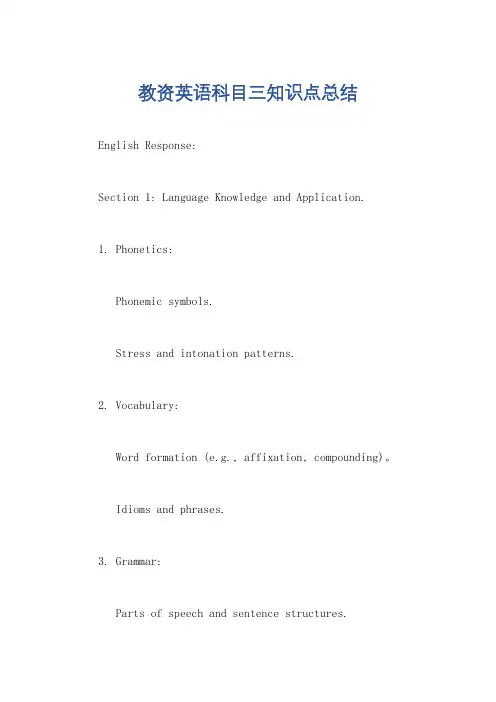
教资英语科目三知识点总结English Response:Section 1: Language Knowledge and Application.1. Phonetics:Phonemic symbols.Stress and intonation patterns.2. Vocabulary:Word formation (e.g., affixation, compounding)。
Idioms and phrases.3. Grammar:Parts of speech and sentence structures.Conditional sentences, passive voice, reported speech.4. Translation:Techniques for translating between English and Chinese.Section 2: Language Teaching Methodology.1. Teaching principles:Communicative language teaching, task-based learning.2. Lesson planning:Principles of lesson design, materials selection.3. Teaching methods:Pair work, group work, authentic materials.4. Assessment:Principles of assessment, types of assessments.Section 3: Language and Culture.1. Language and society:The role of language in communication and culture.2. Intercultural communication:Cross-cultural differences and strategies for effective communication.3. Cultural products:Literature, music, art, and their importance in language learning.Section 4: Educational Theory and Practice.1. Educational psychology:Learning theories, motivation, individual differences.2. Classroom management:Creating a positive learning environment, discipline techniques.3. Educational technology:Using technology to enhance language learning.4. Professional development:Refection, continuing education.中文回答:一、语言知识与应用。
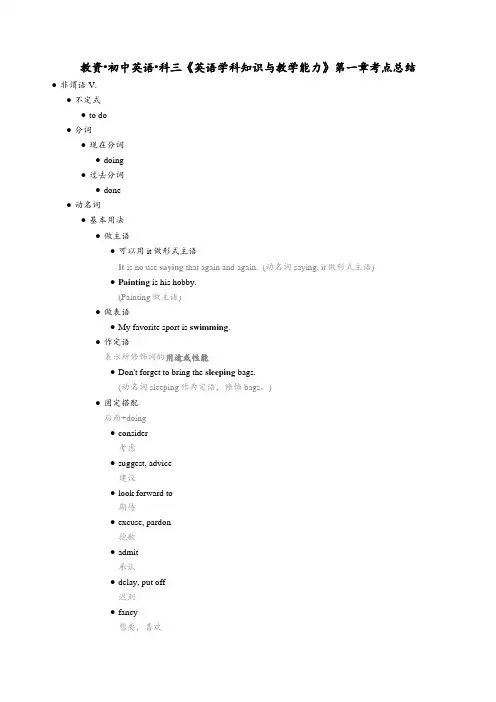
教资•初中英语•科三《英语学科知识与教学能力》第一章考点总结●非谓语V.●不定式●to do●分词●现在分词●doing●过去分词●done●动名词●基本用法●做主语●可以用it做形式主语It is no use saying that again and again. (动名词saying, it做形式主语)●Painting is his hobby.(Painting做主语)●做表语●My favorite sport is swimming.●作定语表示所修饰词的用途或性能●Don't forget to bring the sleeping bags.(动名词sleeping作为定语,修饰bags。
)●固定搭配后面+doing●consider考虑●suggest, advice建议●look forward to期待●excuse, pardon抱歉●admit承认●delay, put off迟到●fancy想要,喜欢●avoid避免●Can't help情不自禁●mind介意●allow, permit允许●escape逃跑,逃避●动名词的复合结构名词所有格/ 形容词性物主代词+动名词(one's doing)●介意我开窗。
Mind my opening。
(主要强调人“我”)●Her being late made boss angry(复合形式, 在动词made前做主语)●时态语态●●独立主格有两个句子,且两个句子的主语不是指同一个。
●句子中已经有完整的谓语时●there being+名词/代词表示“有”●There being nothing else to do, they went home.●it being+名词/代词表示“是”●It being a holidaym, all the shops were shut.●名词/代词+介词短语介词短语前后的名词前没有修饰词●A young lady came over, dictionary in hand.●with/without+宾语+介词短语介词短语前后的名词前有修饰词●A young lady came over, with a dictionary in her hand.。
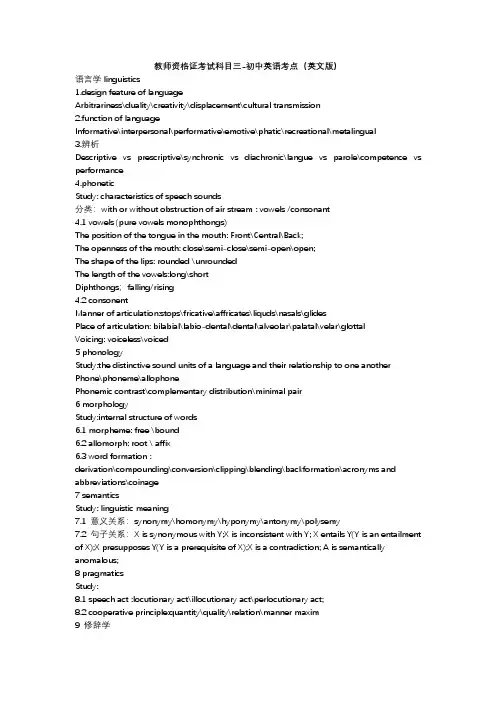
教师资格证考试科目三-初中英语考点(英文版)语言学linguistics1.design feature of languageArbitrariness\duality\creativity\displacement\cultural transmission2.function of languageInformative\interpersonal\performative\emotive\phatic\recreational\metalingual3.辨析Descriptive vs prescriptive\synchronic vs diachronic\langue vs parole\competence vs performance4.phoneticStudy: characteristics of speech sounds分类:with or without obstruction of air stream : vowels /consonant4.1 vowels (pure vowels monophthongs)The position of the tongue in the mouth: Front\Central\Back;The openness of the mouth: close\semi-close\semi-open\open;The shape of the lips: rounded \unroundedThe length of the vowels:long\shortDiphthongs;falling/rising4.2 consonentManner of articulation:stops\fricative\affricates\liquds\nasals\glidesPlace of articulation: bilabial\labio-dental\dental\alveolar\palatal\velar\glottalVoicing: voiceless\voiced5 phonologyStudy:the distinctive sound units of a language and their relationship to one anotherPhone\phoneme\allophonePhonemic contrast\complementary distribution\minimal pair6 morphologyStudy:internal structure of words6.1 morpheme: free \bound6.2 allomorph: root \ affix6.3 word formation :derivation\compounding\conversion\clipping\blending\backformation\acronyms and abbreviations\coinage7 semanticsStudy: linguistic meaning7.1 意义关系:synonymy\homonymy\hyponymy\antonymy\polysemy7.2 句子关系:X is synonymous with Y;X is inconsistent with Y; X entails Y(Y is an entailment of X);X presupposes Y(Y is a prerequisite of X);X is a contradiction; A is semantically anomalous;8 pragmaticsStudy:8.1 speech act :locutionary act\illocutionary act\perlocutionary act;8.2 cooperative principle:quantity\quality\relation\manner maxim9 修辞学Simile\metaphor\metonymy\synecdoche\alliteration\endrhyme\oxymoron\pun\euphemism\parallelism\exaggeration\personification\irony\onomato poeia\synesthesia\transferred\spoonerism外语教学理论1 view on language: the structural view of language;\the functional view of language;\ the ineractional view of language;2 views on language learning:behaviorist theory; \cognitive theory; \constructivist theory; \socio-constructivist theory。
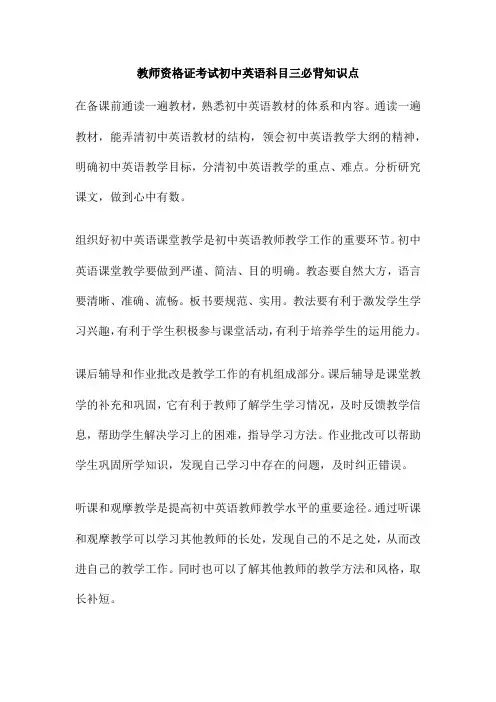
教师资格证考试初中英语科目三必背知识点在备课前通读一遍教材,熟悉初中英语教材的体系和内容。
通读一遍教材,能弄清初中英语教材的结构,领会初中英语教学大纲的精神,明确初中英语教学目标,分清初中英语教学的重点、难点。
分析研究课文,做到心中有数。
组织好初中英语课堂教学是初中英语教师教学工作的重要环节。
初中英语课堂教学要做到严谨、简洁、目的明确。
教态要自然大方,语言要清晰、准确、流畅。
板书要规范、实用。
教法要有利于激发学生学习兴趣,有利于学生积极参与课堂活动,有利于培养学生的运用能力。
课后辅导和作业批改是教学工作的有机组成部分。
课后辅导是课堂教学的补充和巩固,它有利于教师了解学生学习情况,及时反馈教学信息,帮助学生解决学习上的困难,指导学习方法。
作业批改可以帮助学生巩固所学知识,发现自己学习中存在的问题,及时纠正错误。
听课和观摩教学是提高初中英语教师教学水平的重要途径。
通过听课和观摩教学可以学习其他教师的长处,发现自己的不足之处,从而改进自己的教学工作。
同时也可以了解其他教师的教学方法和风格,取长补短。
课外活动是初中英语教学工作的重要组成部分。
通过开展各种形式的课外活动可以激发学生学习英语的兴趣和积极性,增强学生的英语实践能力。
如开展英语角、英语演讲比赛、英语歌曲比赛等活动可以为学生提供运用英语的机会,提高学生的英语口语表达能力。
教学目标是教学实施的基础,也是教学设计的核心。
在教师资格证考试中,初中英语的教学目标应该从语言知识、语言技能、情感态度、学习策略和文化意识五个方面进行描述和设计。
语言知识目标:让学生掌握初中英语的基本词汇、语法和语言表达方式,能够正确地使用英语进行口头和书面表达。
语言技能目标:培养学生的听、说、读、写四项基本技能,使学生能够运用这些技能进行有效的交流和信息获取。
情感态度目标:通过英语学习,培养学生的自信心和积极性,使学生对英语文化和英语国家有更深入的了解,激发其学习兴趣和求知欲。
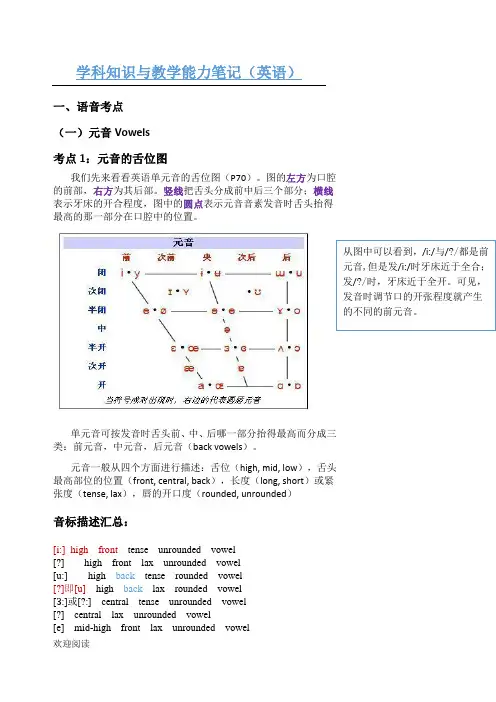
学科知识与教学能力笔记(英语)一、语音考点(一)元音Vowels考点1:元音的舌位图我们先来看看英语单元音的舌位图(P70)。
图的左方为口腔的前部,右方为其后部。
竖线把舌头分成前中后三个部分;横线音标描述汇总:[i:] h igh front tense unrounded vowel[?] high front lax unrounded vowel[u:] high back tense rounded vowel[?]即[u] high back lax rounded vowel[З:]或[?:] central tense unrounded vowel[?] central lax unrounded vowel[e] mid-high front lax unrounded vowel[?] low front lax unrounded vowel [Λ] mid-low back lax unrounded vowel [?:] mid-low back tense rounded vowel [?] low back lax rounded vowel [ɑ:] low back tense unrounded vowel考点2:专有名词基本元音 Cardinal Vowels纯元音Pure Vowels/单元音 Monophthong Vowels如:[aI] 中[a 考点1:Manners of articulation 发音方式 stops 爆破音 [p, b, t, d, k, g] nasal 鼻音 [m, n, ?]fricative 摩擦音 [f, v, θ, e, s, z, ∫, ?, h]、approximant近似音[w, r, j ]、lateral边音[l]、affricate塞擦音[ts, dz, tr, dr]考点2:Places of articulation发音部位[p][b][t][d][k][g][m][n][?][f][v][?][e][s][z][∫] voiceless postalveolar fricative[?] voiced postalveolar fricative[h] glottal fricative[t∫] voiceless postalveolar affricate [d?] voiced postalveolar affricate[l ] alveolar lateral[r] alveolar approximant[w] bilabial approximant[j] palatal approximant(三)Assimilation同化现象:a process by which one sound takes on some or all characteristics of a neighboring sound.Nasalization鼻音化、cap canDentalization齿音、tent tenthVelarization软腭since sinkVoiced frication有声擦音→voiceless无声擦音/__voiceless清音重音。
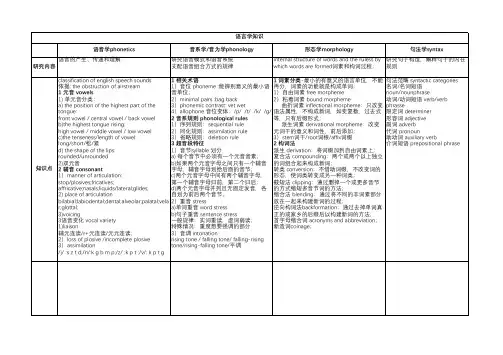
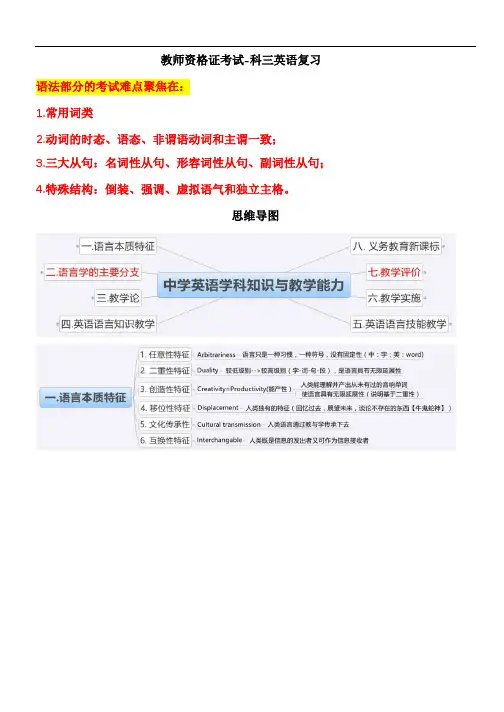

教师资格证外语教育知识与能力简答题归
纳汇总
第一部分语言知识
语音知识
- 拼音规则及应用
- 四声规律和变调规律
- 音节结构、重读和轻读
- 特殊音(拼音中特有的音)
- 声调的意义、类型及区分
- 浊音、清音的发音及特点
- 同音异调、同调异音、多音字及其应用
- 外语中的读音规律及英语中重读音节规律
语法知识
- 中文句子成分及其功能
- 并列句、复合句和简单句的概念、特征、类型和结构
- 句子的语序及其特点
- 语法关系(主谓关系、动宾关系、定状补关系、并列关系、从属关系)
- 助动词的种类、用法及其含义
- 外语语法中的基本句型和时态
词汇知识
- 词类及其区分
- 同义词、反义词的辨析
- 单词的构成及其排序
- 多义词、近义词和错误词用法
第二部分形式与技巧
外语教学中的思维技巧
- 思维的类型和层次
- 思维技巧的种类和难点
外教教学中的语言技巧
- 外教教学中的情景语言(简介、道歉、询问等常用情景)
- 外教教学中的听说技巧(如声音的语调、正确发音等)
- 教学中的情态动词(如“可以”、“应该”等)
外语教学中的心理技巧
- 研究的目标和难点
- 研究的心态
结束语
以上就是本文对于教师资格证外语教育知识与能力简答题的归纳汇总,只要认真掌握上述内容,并且在实践中多加运用,相信一定能够取得优异的成绩。
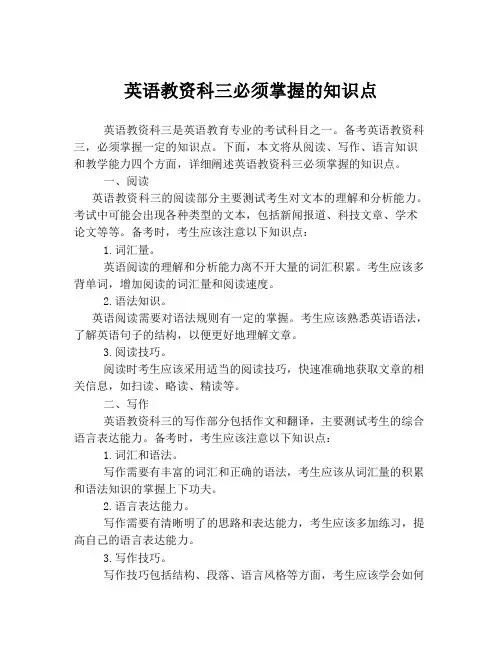
英语教资科三必须掌握的知识点英语教资科三是英语教育专业的考试科目之一。
备考英语教资科三,必须掌握一定的知识点。
下面,本文将从阅读、写作、语言知识和教学能力四个方面,详细阐述英语教资科三必须掌握的知识点。
一、阅读英语教资科三的阅读部分主要测试考生对文本的理解和分析能力。
考试中可能会出现各种类型的文本,包括新闻报道、科技文章、学术论文等等。
备考时,考生应该注意以下知识点:1.词汇量。
英语阅读的理解和分析能力离不开大量的词汇积累。
考生应该多背单词,增加阅读的词汇量和阅读速度。
2.语法知识。
英语阅读需要对语法规则有一定的掌握。
考生应该熟悉英语语法,了解英语句子的结构,以便更好地理解文章。
3.阅读技巧。
阅读时考生应该采用适当的阅读技巧,快速准确地获取文章的相关信息,如扫读、略读、精读等。
二、写作英语教资科三的写作部分包括作文和翻译,主要测试考生的综合语言表达能力。
备考时,考生应该注意以下知识点:1.词汇和语法。
写作需要有丰富的词汇和正确的语法,考生应该从词汇量的积累和语法知识的掌握上下功夫。
2.语言表达能力。
写作需要有清晰明了的思路和表达能力,考生应该多加练习,提高自己的语言表达能力。
3.写作技巧。
写作技巧包括结构、段落、语言风格等方面,考生应该学会如何拓展自己的写作思路,提高写作的水平。
三、语言知识英语教资科三的语言知识部分包括音、形、义方面的考察,考试难度较高。
备考时,考生应该注意以下知识点:1.单词拼写。
考生应该掌握英语常用单词的拼写,多加练习,提高自己的拼写水平。
2.词汇语义。
英语单词有不同的含义,考生应该正确理解单词的含义,做到用词准确。
3.语法和语言表达能力。
语言知识部分也会考察考生的语法和语言表达能力,考生需要掌握英语语法,并提高自己的语言表达能力。
四、教学能力英语教育专业需要掌握良好的教学能力,包括教学理论、教学设计和教学实践等方面。
备考时,考生应该注意以下知识点:1.教育心理学。
了解学生的需求和心理状态,掌握教育心理学的相关知识,可以更好地进行教学设计。
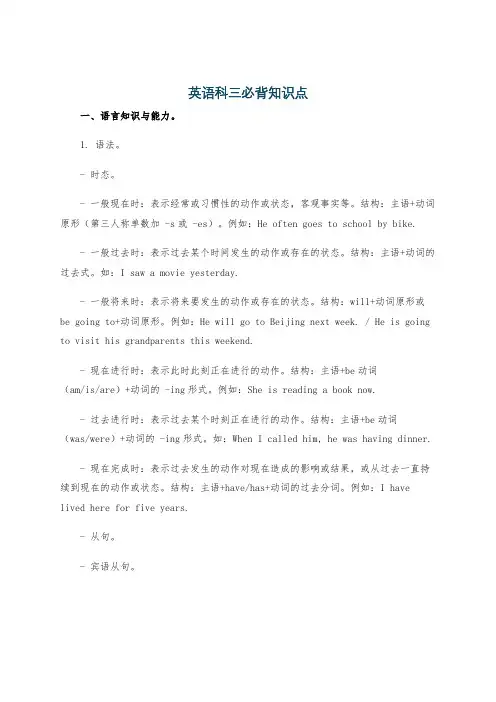
英语科三必背知识点一、语言知识与能力。
1. 语法。
- 时态。
- 一般现在时:表示经常或习惯性的动作或状态,客观事实等。
结构:主语+动词原形(第三人称单数加 -s或 -es)。
例如:He often goes to school by bike.- 一般过去时:表示过去某个时间发生的动作或存在的状态。
结构:主语+动词的过去式。
如:I saw a movie yesterday.- 一般将来时:表示将来要发生的动作或存在的状态。
结构:will+动词原形或be going to+动词原形。
例如:He will go to Beijing next week. / He is going to visit his grandparents this weekend.- 现在进行时:表示此时此刻正在进行的动作。
结构:主语+be动词(am/is/are)+动词的 -ing形式。
例如:She is reading a book now.- 过去进行时:表示过去某个时刻正在进行的动作。
结构:主语+be动词(was/were)+动词的 -ing形式。
如:When I called him, he was having dinner.- 现在完成时:表示过去发生的动作对现在造成的影响或结果,或从过去一直持续到现在的动作或状态。
结构:主语+have/has+动词的过去分词。
例如:I have lived here for five years.- 从句。
- 宾语从句。
- 连接词:that(可省略),if/whether,特殊疑问词(what, who, when等)。
例如:He said (that) he liked English. I don't know if/whether hewill come. Do you know what he is doing?- 语序:宾语从句要用陈述句语序。
如:I wonder when he will arrive.(不能写成I wonder when will he arrive.)- 定语从句。
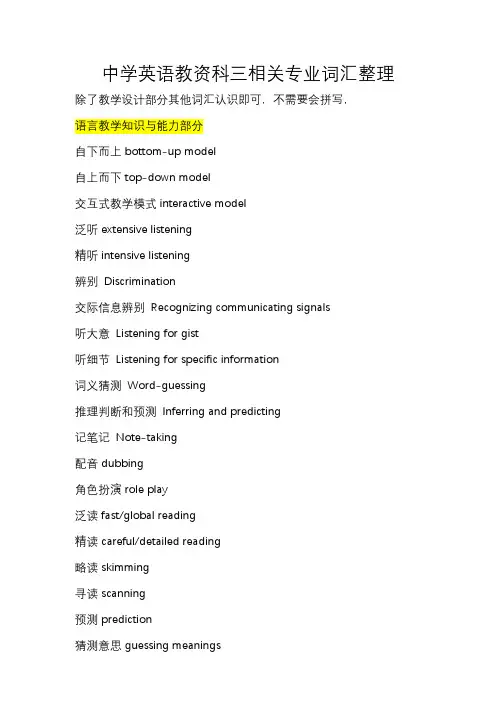
中学英语教资科三相关专业词汇整理除了教学设计部分其他词汇认识即可,不需要会拼写,语言教学知识与能力部分自下而上bottom-up model自上而下top-down model交互式教学模式interactive model泛听extensive listening精听intensive listening辨别Discrimination交际信息辨别Recognizing communicating signals听大意Listening for gist听细节Listening for specific information词义猜测Word-guessing推理判断和预测Inferring and predicting记笔记Note-taking配音dubbing角色扮演role play泛读fast/global reading精读careful/detailed reading略读skimming寻读scanning预测prediction猜测意思guessing meanings推理Inferring识别指代关系(Recognizing the Reference)结果导向模式(The Product-oriented Model)过程导向模式(The Process-oriented Model)内容导向模式(The Content-oriented Model)头脑风暴(Brainstorming)思维导图(Mapping)列提纲(Outlining)写初稿(Drafting)自改(Self-editing)互相修改(Peer-editing)订正(Revising)评价(Evaluating)控制性写作(Controlled writing)指导性写作(Guided writing)交流性写作(Expressive writing)系统性原则(Systematic principle)应用原则(Application principle)呈现原则(Presentation principle)文化性原则(Culture principle)词汇选择原则(Word-choice principle)演绎法(deductive)归纳法(inductive)机械训练(Mechanical Practice)替换操练(substitution drills)转换操练(transformation drills)意义性练习(Meaningful Practice)语法翻译法(Grammar-translation Method)直接法(Direct Method)听说法(The Audio-lingual method)认知法(Cognitive Method)交际法(Communicative Language Teaching Approach)视听法(The Audio Visual Approach)情景教学法(Situational teaching method)全身反应法(Total Physical Response,TPR)任务型教学法(Task-based Language Teaching Method) (TBLT)拼图式任务(jigsaw tasks)信息沟活动(information gap tasks)解决问题型任务(problem-solving tasks)选择决定型任务(decision-making tasks)交流观点型任务(opinion exchange tasks)教学设计部分Teaching contents 教学内容Teaching objectives 教学目标Teaching key point and difficult point 教学重难点Teaching methods 教学方法Teaching aids 教具Teaching procedures 教学过程Blackboard design 板书设计Teaching reflection 教学反思Task-based Language Teaching Method(TBLT)(任务型教学法)Communicative Language Teaching Approach(交际型教学法)Situational Language Teaching Method(情景教学法)Total Physical Response(TPR)(全身反应法)Audio-lingual Method(听说法)Cooperative Learning Method 合作学习法Independent/Autonomous(自主的)Learning Method 自主学习法Knowledge objective(s)知识目标Ability objective(s)能力目标Emotional objective(s)情感目标教学实施与评价部分指导者(Instructor)控制者(Controller)评价者(Assessor)组织者(Organizer)提示者(Prompter)促进者(Facilitator)参与者(Participant)研究者(Researcher)资源提供者(Resource-provider)全班活动(Class work)小组活动(Group work)结对活动(Pair work)个人活动(Individual work)开放性问题(open question)封闭性问题(closed question)展示性问题(display question)参考性问题(referential question)直接纠错(Explicit correction)间接纠错(Implicit correction)重述法(Recasting)重复法(Repetition)强调法(Pinpointing)元语言提示法(Metalinguistic feedback)澄清法(Clarification request)启发法(Elicitation)诊断性评价(Diagnostic Assessment)调查与测验(quiz&questionnaire)观察与访谈(observation&interview)形成性评价(Formative Assessment)评价量表(evaluation scale)概念图(concept map)终结性评价(Summative Assessment)口试(oral test)笔试(written test)标准参照评价(Criterion-referenced assessment)常模参照评价(Norm-referenced assessment)个体参照评价(Individual-referenced assessment)成绩测试(Achievement test)水平测试(Proficiency test)潜能测试(Aptitude test)诊断测试(Diagnostic test)常模参照测试(Norm-referenced Tests)标准参照测试(Criterion-referenced Tests)信度(Reliability)区分度(Discrimination)难度(Difficulty)效度(Validity)表面效度(Face Validity)结构效度(Construct Validity)内容效度(Content Validity)教学日志(Teaching journal)叙事研究(Narrative research)行动研究(Action research)语言学部分语言学(Linguistics)Langue & Parole(语言和言语)Prescriptive & Descriptive(规定性和描述性)Synchronic & Diachronic(共时性和历时性)Competence & Performance(语言能力和语言表现)任意性(Arbitrariness)二重性(Duality)创造性(Productivity)移位性(Displacement)文化传播性(Cultural transmission)信息功能(Informative function)人际功能(Interpersonal function)施为功能(Performative function)情感功能(Emotive function)寒暄功能(Phatic function)娱乐功能(Recreational function)元语言功能(Metalinguistic function)语音学(Phonetics)元音(vowels)辅音(consonants)舌头最高部分的位置(position of the highest part of the tongue) 前元音(front vowel)中元音(central vowel)后元音(back vowel)舌头抬起的高度(the height of tongue rising)高元音(high vowel)中元音( middle vowel)低元音(low vowel)长元音(long vowel)短元音(short vowel)圆唇音(rounded vowel)非圆唇音(unrounded vowel)发音方式(Manner of articulation)发音部位(Place of articulation)带声性(Voicing;vibration of the vocal cords)清辅音(Voiceless sound)浊辅音(Voiced sound)爆破音(Stops/Plosives)摩擦音(Fricatives) 塞擦音(Affricates) 鼻音(Nasals)流音(Liquids/Lateral) 滑音(Glides) 双唇音(Bilabial)唇齿音(Labiodental)齿间音(Dental)齿龈音(Alveolar)硬颚音(Palatal)软腭音(Velar)声门音(Glottal)语音变化(Vocal Variety) 连读(Liaison) 失去爆破(Loss of Plosive)不完全爆破(incomplete plosive) 同化(Assimilation)音系学(Phonology)音素(Phone) 音位(phoneme)最小对立体(minimal pairs) 音位对立(phonemic contrast)音位变体(Allophone)互补分布(complementary distribution)自由变体(Free variation)序列规则(Sequential rule)同化规则(Assimilation rule)省略规则(Deletion rule)音节(syllable)重音(Stress)单词重音(word stress)句子重音(sentence stress)语调(intonation)升调(rising tone)降调(falling tone)降升调(falling-rising tone) 升降调(rising-falling tone) 形态学(Morphology)词素(Morpheme) 自由词素(free morphemes)黏着词素(bound morphemes)词根(root)词缀(affix)前缀(prefix)后缀(suffix)中缀(infix)词干(stem)屈折词缀(inflectional affix)派生词缀(derivational affix)词的构成(word formation)复合法(compounding)向心复合词(endocentric compound)离心复合词(exocentric compound)派生法(derivation)创新词(invention) 混成词(blending)截断词(clipping/abbreviation)首字母连写词(initialism)首字母拼写词(acronym)逆构词法(back-formation)类推构词(analogical creation)借词法(borrowing/loanword)语义学(Semantics)外延意义(Denotation)内涵意义(Connotation)同义关系(synonymy)文体(stylistic) 差别地域(dialectal) 差别搭配(collocational) 差别情感(emotive)差别语义(semantic) 差别反义关系(Antonymy)反义词(antonym)的关系等级反义(gradable antonymy)互补反义(complementary antonymy)反向反义(converse antonymy)上下位关系(Hyponymy)一词多义(Polysemy)同音/同形异义(Homonymy)同音异义(homophone)同形异义(homograph)同形同音异义(complete homonym)句子间涵义关系(Sense relations between sentences)X is synonymous with Y (X 与Y 同义)X is inconsistent with Y (X 与Y 不一致)X entails Y/Y is an entailment of X(X 蕴含Y)X presupposes Y/Y is a prerequisite of X(预设关系)X is a contradiction(X 自我矛盾)语用学(Pragmatics)言语行为(speech acts)言内行为/发话行为(locutionary act)言外行为/行事行为(illocutionary act)言后行为/取效行为(Perlocutionary act)直接言语行为(direct speech act)间接言语行为(indirect speech act)会话含义理论(Conversational implicature )合作原则(Cooperative principle)数量准则(The maxim of quantity)质量准则(The maxim of quality)关系准则(The maxim of relevance)方式准则(The maxim of Manner)修辞学(Rhetoric)明喻(Simile)暗喻(Metaphor)转喻/换喻/借代(Metonymy)提喻(Synecdoche)隐喻(Allusion)拟人(Personification)夸张(Hyperbole)矛盾修饰法(Oxymoron)委婉(Euphemism)移就(Transferred Epithet)押韵(Rhyme)押头韵(Alliteration/Initial rhyme/Head rhyme)押尾韵(End rhyme)反韵(Reverse rhyme)准押韵(Assonance)意群(sense group)停顿(pausing)节奏(rhythm)替换(substitution)双关(pun)反语(irony)讽刺(sarcasm)习得假说(The Acquisition-learning Hypothesis)语言输入假说(Input Hypothesis)情感过滤假说(Affective-filter Hypothesis)自然顺序假说(The Natural Order Hypothesis)监察假说(Monitor Hypothesis)语言输出假说(Output Hypothesis)互动假说(Interaction Hypothesis)中介语(Interlanguage)僵化现象(Fossilization)结构型教学大纲(Structural syllabus)功能-意念型教学大纲(Functional-notional syllabus)任务型教学大纲(Task-based syllabus)内容型教学大纲(Content-based syllabus)技能型教学大纲(Skill-based syllabus)体裁型教学大纲(Genre-based syllabus)。
2023教资科三英语考点归纳一、教育心理学部分1. 学习理论:行为主义、认知主义、人本主义、建构主义等,每个理论的重点概念和代表人物需熟记。
2. 迁移理论:贾德、形式训练说、关系联想说、经验类化说、认知结构说等,理解并掌握其应用场景。
3. 教学模式:个别化教学、班级授课制、探究式教学等,每种教学模式的特点和优缺点需牢记。
二、语言学部分1. 语音和语调:正确识别单词和短语中的语音,正确表达语调(重音、语调、节奏)对于语义的影响。
2. 语法和词汇:熟练掌握语法规则,能够准确识别和正确书写英语句子,对常用词汇的含义和用法有深入理解。
3. 口语表达:熟练掌握常用的日常用语和课堂用语,能够流畅地进行口语表达。
4. 阅读教学:理解阅读技能和策略,如预测、略读、扫读等,以及如何引导学生进行有效的阅读。
5. 写作教学:熟悉常用的写作教学策略和评估方法,能够指导学生对写作进行规划和修改。
三、语言教学部分1. 教学方法:了解各种教学方法的理论基础和应用场景,如直接法、听说法、交际法等。
2. 课程设计:熟悉课程设计的原则和方法,包括课程目标的设定、教材的选择和组织、教学活动的设计等。
3. 评估与反馈:了解各种评估方法(如形成性评估、终结性评估)的优缺点和应用场景,以及如何给予有效的反馈。
4. 文化教学:了解文化在英语教学中的重要性,以及如何将文化教学融入日常教学。
5. 现代教育技术:熟悉现代教育技术的理论和实践,如多媒体教学、网络教学等,如何利用这些技术提高教学效果。
四、教育政策法规部分1. 教育基本制度:《教育法》、《教师法》、《义务教育法》等相关法律法规需熟知。
2. 教育教学政策:了解国家及地方的教育方针政策,如素质教育、课程改革等。
3. 学生管理政策:了解学生管理的相关规定,如考试管理、学籍管理、处分等。
4. 安全教育法规:重视安全教育的重要性,熟知相关法规和安全防范措施。
总之,要想取得良好的教资科三英语成绩,需要全面系统地掌握考点,并不断练习巩固。
高中英语教资科三知识点总结一、教学任务及对象1、教学任务本教学设计旨在针对高中英语教资科三的知识点进行总结。
教学任务包括对英语语言知识的系统梳理,特别是语法、词汇、阅读理解、写作技巧等方面,同时注重培养学生运用英语进行实际沟通的能力。
通过本次教学,使学生全面掌握科三考试所涉及的各项知识点,提高英语综合运用水平,为顺利通过教资考试打下坚实基础。
2、教学对象本教学设计面向高中阶段的学生,特别是准备参加英语教资科三考试的学生。
这些学生具备一定的英语基础,但在知识点的掌握上可能存在不牢固、不系统的问题。
教学过程中,需要关注学生的个体差异,因材施教,使他们在本次教学中能够查漏补缺,提高自身英语素养。
同时,鼓励学生积极参与课堂活动,培养他们的自主学习能力和团队合作精神。
二、教学目标1、知识与技能(1)掌握高中英语教资科三的全部语法知识点,包括时态、语态、非谓语动词、名词性从句、定语从句等,并能熟练运用到实际语境中。
(2)积累丰富的词汇量,学会使用各种词汇学习策略,如词根词缀法、联想记忆法等,提高英语阅读和写作能力。
(3)掌握阅读理解技巧,如快速浏览、寻读、精读等,提高阅读速度和准确率,增强语篇分析能力。
(4)学会英语写作技巧,包括文章结构、论证方法、过渡词等,能独立完成各类写作任务,如议论文、叙述文、说明文等。
(5)具备基本的英语听说能力,能听懂日常英语对话、新闻报道等,并能进行简单的口头表达和交流。
2、过程与方法(1)采用任务型教学法,引导学生通过完成具体任务来学习和巩固知识点,提高实际运用能力。
(2)运用启发式教学,激发学生的思维和创新能力,培养他们独立思考和解决问题的能力。
(3)鼓励学生进行合作学习,通过小组讨论、角色扮演等活动,提高团队合作意识和沟通能力。
(4)利用多媒体教学资源,如网络、音频、视频等,丰富教学手段,提高学生的学习兴趣和积极性。
3、情感,态度与价值观(1)培养学生对英语学习的兴趣和热情,使他们树立自信心,克服学习困难,积极面对挑战。
教资科三英语知识点教育部教资考试科目三英语是对考生英语语言知识和应用能力的测试。
以下是科三英语常见的知识点,供参考。
一、听力理解1.短对话理解:考察考生对于日常生活中短对话的理解能力。
主要包括询问信息、提出建议、表达意见等方面的对话。
2.长对话理解:考察考生对于较长对话或文章的理解能力。
主要考察考生对于对话内容、人物之间关系、具体细节等方面的理解。
二、单词理解与应用1.基础单词:考察考生对于常见单词的理解和应用,如数字、颜色、天气、动物、交通工具等。
2.高级单词:考察考生对于较高级单词的理解和应用,如感情词汇、学科名词、社交场合用语等。
三、语法1.时态:考察考生对于英语各种时态的掌握和应用,如一般现在时、过去时、将来时等。
2.名词:考察考生对于不同名词的分类和用法,如可数名词、不可数名词、复数形式等。
3.形容词和副词:考察考生对于形容词和副词的用法和比较级、最高级的掌握。
4.冠词:考察考生对于冠词的用法和区分,如定冠词和不定冠词的使用。
5. 介词:考察考生对于常见介词的掌握和应用,如in、on、at等。
6.代词:考察考生对于代词的理解和应用,如人称代词、指示代词、反身代词等。
四、阅读理解1.短文理解:考察考生对于简短文章的理解能力,主要包括对文章主旨、中心思想、作者观点等的理解。
2.长文理解:考察考生对于长篇文章的理解能力,主要包括对文章结构、段落划分、关键信息等的理解。
五、写作能力1.句子构造:考察考生对于正确句子结构的掌握和运用能力,如主谓宾结构、并列句、复合句等。
2.日常应用:考察考生对于日常生活中常用句子和表达方式的掌握和应用能力,如问候、感谢、道歉等。
3.短文写作:考察考生对于短文写作能力,主要包括句子连接、段落组织、语言流畅性等方面的要求。
六、口语表达1.对话:考察考生进行日常对话的能力,主要包括问答、表达意见、请求帮助等方面的口语表达。
2.情景交际:考察考生在特定情境下的口语表达能力,如问路、购物、就餐等。
科目三英语教学知识点总结1. IntroductionSubject Three English is an important part of the overall English learning process. It usually covers listening, speaking, reading, and writing skills, and aims to help students improve their language proficiency and communication ability. In this article, we will summarize some key teaching knowledge points for Subject Three English, including teaching methods, materials, and assessment.2. Teaching Methods2.1 Communicative Language Teaching (CLT)CLT is a widely used teaching method for Subject Three English. It emphasizes the importance of communication and interaction in language learning. Teachers should provide students with opportunities to practice using English in real-life situations, such as role-plays, discussions, and pair/group activities. By using CLT, students can improve their speaking and listening skills, as well as their overall fluency and accuracy in English.2.2 Task-based Language Teaching (TBLT)TBLT is another effective teaching method for Subject Three English. It focuses on using language to accomplish real tasks, such as giving directions, making requests, and solving problems. Teachers should design tasks that are meaningful and relevant to students' lives, and provide them with the necessary language input and guidance to complete the tasks successfully. By using TBLT, students can develop their language skills in a more natural and authentic way.2.3 Content-based Instruction (CBI)CBI is also a useful teaching method for Subject Three English. It integrates language learning with subject content, such as science, history, or literature. Teachers should select materials and activities that are related to the students' interests and needs, and provide them with opportunities to learn English in the context of various subjects. By using CBI, students can improve their language proficiency while learning about different topics at the same time.3. Teaching Materials3.1 Authentic MaterialsAuthentic materials, such as newspapers, magazines, and websites, are useful for teaching Subject Three English. They provide students with real-life language input and help them develop their reading and listening skills. Teachers should select materials that are appropriate for the students' level and interests, and design activities to help them understand and use the language in context.3.2 Audio-visual MaterialsAudio-visual materials, such as videos, audios, and multimedia resources, are also important for teaching Subject Three English. They provide students with opportunities to listen to authentic spoken English and improve their listening skills. Teachers should use a variety of audio-visual materials to cater to different learning styles and preferences, and design activities to help students understand and practice the language effectively.3.3 Textbooks and WorkbooksTextbooks and workbooks are commonly used in teaching Subject Three English. They provide students with structured language input and practice activities, and help them develop their reading and writing skills. Teachers should select textbooks and workbooks that are suitable for the students' level and needs, and supplement them with additional materials and activities to enhance the learning experience.4. Assessment4.1 Formative AssessmentFormative assessment is an ongoing process that helps teachers monitor students' progress and provide them with feedback for improvement. Teachers should use a variety of assessment strategies, such as quizzes, presentations, and observations, to gather information about students' language skills and performance. By using formative assessment, teachers can identify students' strengths and weaknesses and adjust their teaching accordingly.4.2 Summative AssessmentSummative assessment is a final evaluation of students' language proficiency and achievement. Teachers should use a variety of assessment tools, such as tests, projects, and portfolios, to measure students' overall language skills and knowledge. By using summative assessment, teachers can make informed decisions about students' learning outcomes and provide them with appropriate feedback and support.4.3 Performance AssessmentPerformance assessment is an authentic assessment of students' language skills in real-life situations. Teachers should design tasks and activities that require students to use English to complete specific tasks, such as giving a presentation, participating in a discussion, or writing a report. By using performance assessment, teachers can evaluate students' ability to use English in practical contexts and provide them with valuable feedback for improvement.5. ConclusionIn conclusion, Subject Three English is an important part of the overall English learning process, and it requires effective teaching methods, materials, and assessment strategies to help students develop their language proficiency and communication ability. By using communicative language teaching, task-based language teaching, and content-based instruction, teachers can provide students with meaningful language input and practice opportunities. By using authentic materials, audio-visual materials, textbooks, and workbooks, teachers can create a rich learning environment for students. And by using formative assessment, summative assessment, and performance assessment, teachers can monitor students' progress, evaluate their language skills, and provide them with valuable feedback and support. Overall, effective teaching knowledge points for Subject Three English are crucial for helping students achieve success in their language learning journey.。
高中英语教资科目三知识点总结1. 词汇量的积累是学好英语的基础,需要大量的阅读和实际应用来巩固记忆。
2. 掌握词汇的各种变形形式能够有效提高阅读和写作的能力。
3. 词汇的拼写和发音是基础,需要通过反复练习来达到熟练掌握的水平。
4. 需要理解词汇的词义和词性,并能够准确运用于句子和语境中。
1. 英语语法是学习英语的基础,需要系统学习各种句型和语法规则。
2. 需要掌握一些常见的句子结构和语法现象,如倒装、虚拟语气等。
3. 了解并熟练运用各种时态和语态,包括一般现在时、过去时、将来时等。
4. 熟悉宾语从句、定语从句、状语从句等各种从句结构。
1. 高中英语阅读理解是考试的重点,需要通过大量的阅读来提高理解能力。
2. 在阅读过程中要注意提取文章的关键信息,理解文章的主题和中心思想。
3. 掌握一些阅读技巧,如扫读、略读、精读等,以提高阅读速度和准确度。
4. 训练记忆力和理解力,通过做题来巩固阅读理解的能力。
1. 英语写作需要掌握一些常用句型和表达方式,可以通过积累写作素材来提高写作能力。
2. 写作时要注意组织结构和段落的逻辑性,清晰明了地表达自己的观点和思路。
3. 通过多写、多练提高写作的流畅度和连贯性,避免语法错误和拼写错误。
4. 多读一些范文和优秀英语作品,学习他人的写作技巧和表达方式。
总结:高中英语教资科目三知识点总结,包括词汇篇、语法篇、阅读篇和写作篇。
在学习过程中,要注重词汇量的积累、语法规则的学习、阅读理解的训练和写作能力的提高。
通过系统的学习和练习,可以逐步提高英语能力,为教资考试做好准备。